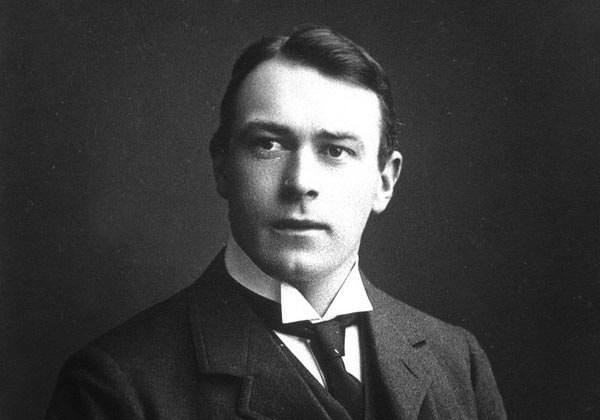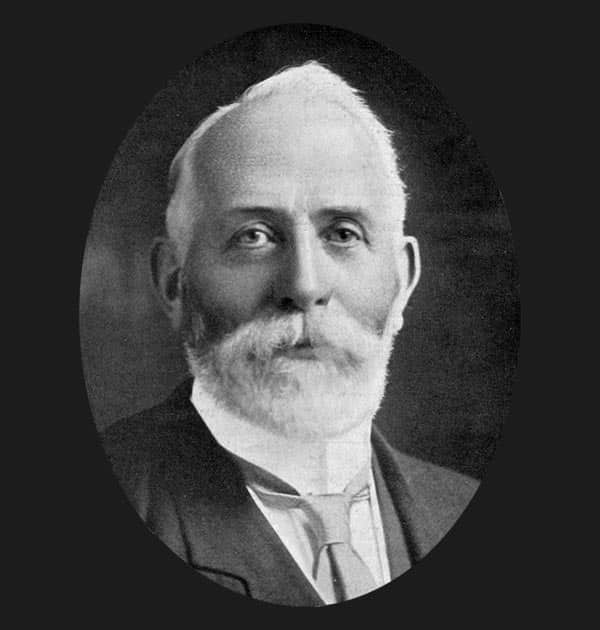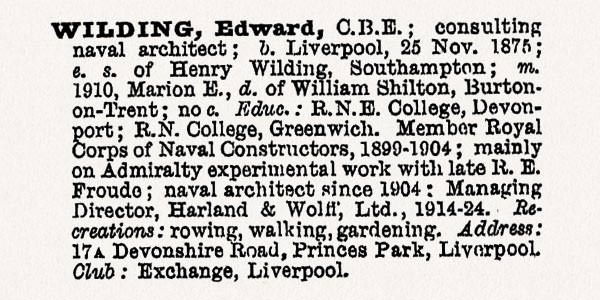Introduction
When people ask who designed the Titanic they are often directed to read about Thomas Andrews, the young designer who died on the maiden voyage. Whilst a poignant and dramatic tale, Andrews’ involvement is just part of the story. The design of Titanic was actually a collaborative affair, with a trio of principal designers made up of Andrews, Alexander Carlisle, and Edward Wilding. Here we give a snapshot of the lives and involvement of all three men.
Thomas Andrews
Thomas Andrews is commonly referred to as the designer of Titanic, to the exclusion of Carlisle and Wilding. Certainly he was the chief naval architect from the summer of 1910, and is generally credited with the structural design of the ships. However, whilst his contribution is certainly significant, caution should be taken not to ignore the other key people who influenced the final appearance and performance of the ships. The fact that Andrews sailed on, and perished in, the maiden voyage of the ship he helped design and build certainly make for a powerful story, and this is probably the reason why the other designers are so often pushed to the margins of the story.

07 February 1873 – the date Andrews was born.
1889 – the year in which Andrews joined Harland & Wolff as a premium apprentice.
16 – the age at which Andrews started his apprenticeship.
1907 – the year Andrews became Managing Director of Harland & Wolff.
24 June 1908 – the date Andrews married Helen Reilly Barbour.
35 – the age at which Thomas married Helen, 27.
29 July 1908 – the date on which representatives of White Star Line arrived in Belfast to give their formal agreement to the plans for Olympic and Titanic (barely more than a month after his wedding).
His was ever the friendly greeting and the warm handshake and kind disposition. -Anonymous yard foreman, Harland & Wolff, describing Thomas Andrews’ character
27 November 1910 – the date a daughter was born to Thomas and Helen, Elizabeth Law Barber Andrews (aka ‘ELBA’), born just over a month after Olympic launched.
4 – the number of servants employed in the Andrews household by 1911 (a cook, a housemaid, a parlour maid and a general servant).
Did You Know?
Intriguingly, despite being a member of such prestigious bodies as the Institution of Naval Architects and the Society of Naval Architects and Marine Engineers, Thomas Andrews often described himself as a ‘Shipbuilder’ or ‘Director’ rather than by the grander, more formal title of Naval Architect.
39 – Andrews’ age when he died in the Titanic disaster.
Alexander Carlisle
Alexander Carlisle preceded Thomas Andrews as chief naval architect, being replaced by the younger man when he stood down. Carlisle is generally thought to have been responsible for much of the internal design of the ships, their fixtures, fittings and equipment.

08 July 1854 – the date Carlisle was born, in Ballymena, County Antrim, Ireland.
11 – the age at which Carlisle started studying at Royal Belfast Academical Institution. Prior to this he had a private tutor.
1870 – the year in which Carlisle was apprenticed to Harland & Wolff.
16 – the age at which Carlisle started his premium apprenticeship.
5 years – the length of an apprenticeship.
40 – the number of years that Carlisle spent at Harland & Wolff, holding positions including chief draughtsman, under manager, shipyard manager, general manager, and chairman of the board of directors.
17 April 1879 – the date that Alexander became brother-in-law to William James Pirrie (later Lord Pirrie), when Pirrie married Margaret Montgomery Carlisle. Pirrie was a partner in (and future chairman of) Harland & Wolff, the Belfast shipyard where Titanic was built.
1890 – the year Carlisle became general manager.
1907 – the year Carlisle became chairman of the board of directors.
January 1910 – the month in which Pirrie and Carlisle travelled from Belfast to the White Star Line offices in Liverpool, to present revised plans, relating to interior decorations and life-saving equipment, to Bruce Ismay and Harold Sanderson (this was their second visit to Liverpool in almost as many months, a prior trip occurring in October 1909).
30 June 1910 – the date Carlisle retired from Harland & Wolff and moved to London (although he remained an adviser and consultant to the company). His position was filled by Lord Pirrie’s nephew, Thomas Andrews
1911 – the year Carlisle became a member of the Merchant Shipping Advisory Committee on Life-Saving Appliances.
May 1911 – the month in which Carlisle’s proposal, to more than double the number of lifeboats planned for Olympic and Titanic, was rejected by the Board of Trade.
3 – the number of children born to Alexander and Edith, a son and two daughters.
Did You Know?
In the book Shipbuilders To The World, the company history of Harland & Wolff, it is stated that Alexander Carlisle resigned from the company due to disagreements with Pirrie. These disagreements may have been based upon Pirrie’s secretive (and some have said, questionable) financial and business affairs, or over disputes about aspects of the design of the Olympic-class ships, such as the plans for the lifeboats.
06 March 1926 – the date Carlisle died, in London.
71 – Carlisle’s age at his death.
Edward Wilding
Edward Wilding was deputy to Thomas Andrews in the design department, succeeding him as the chief naval architect a few years after Andrews was killed in the disaster. During the design stages wilding contributed his expertise in the mathematical calculations relating to the stability, displacement, and hull integrity of the new ships.

Above: The entry for Edward Wilding in the 1926 edition of Who’s Who.
25 November 1875 – the date Wilding was born, in Liverpool, England.
1891 – the approximate year in which Wilding became a naval cadet in the Royal Navy.
15 – the age at which Wilding became a cadet.
20 – the approximate age at which Wilding was promoted to Probationary Assistant Constructor, and commenced a naval architecture course at the Royal Naval College at Greenwich.
3 years – the length of the course.
1899 – the approximate year in which Wilding passed out of Greenwich, aged around 23.
Did You Know?
As well as working closely with Andrews on the design of the ships, Wilding was a friend too, and was a guest at Thomas and Helen’s wedding in 1908.
05 Jul 1910 – the date Edward married Marion Emily Shilton, daughter of William Shilton, in Clifton (now part of Bristol), Gloucestershire, England.
34 – Wilding’s age at the time of his wedding; Emily was around 27 years of age (aged 28 on the 1911 census).
2 – the number of servants in the Wilding household in 1911, a cook and a housemaid.
1913 – the year Wilding was made a general manager at Harland & Wolff.
1915 – the year Wilding became chief naval architect in the designing department at Harland & Wolff.
1920 – the year Wilding was made a Commander of the Order of the British Empire (CBE), probably for his work as a naval architect during the First World War.
Did You Know?
Wilding sailed on Titanic, on the journey from Belfast to Southampton, but he disembarked there.
1924 – the year in which Wilding retired from Harland & Wolff.
1926 – the year Wilding became a consulting naval architect for the Argentine Navigation Company.
1939 – the year Wilding died.
63 – Wilding’s approximate age at his death.
More To Explore
Now you know who designed the Titanic why not read more about the people who built the ship, about Olympic, the sister ship, and about the ill-fated maiden voyage.
